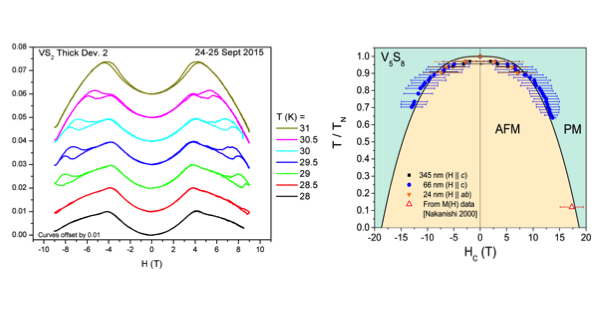Magnetism and Spin
In recent years we have examined magnetic materials on the nanoscale as a part of our work on group of Prof. Emilia Morosan, examining the magnetic system Fe\(_{x}\)TaS\(_{2}\). We found that when \(x=0.28\), this material exhibits a magnetoresistance approaching 100% at low temperatures, as reportedhere. The comparison between bulk crystals and exfoliated pieces was important for establishing the mechanism at work.

Similarly, in collaboration with Prof. Jun Lou's group, we have used transport to examine the thickness dependence of antiferromagnetism in V5S8, and in the course of those experiments we discovered a previously unknown metamagnetic phase transition between the antiferromagnetic phase and a paramagnetic phase. That transition extrapolates to a quantum phase transition at \(T = 0\) and around 19 Tesla.

Recently we have also begun examining the transport of angular momentum in magnetic insulators. Using the spin Hall effect and the inverse spin Hall effect, it is possible to use Pt electrodes to inject and detect spin currents even in magnetic insulators with no charge currents. An example configuration is shown in the figure, where a heater generates a temperature gradient that drives a magnon current, which is then detected by a Pt electrode. This accumulation of spin driven by a temperature gradient is called the spin Seebeck effect. We are working to examine spin transport in a variety of materials, including spin ices andspin liquids, where the low-energy spin-carrying excitations are not traditional magnons.

